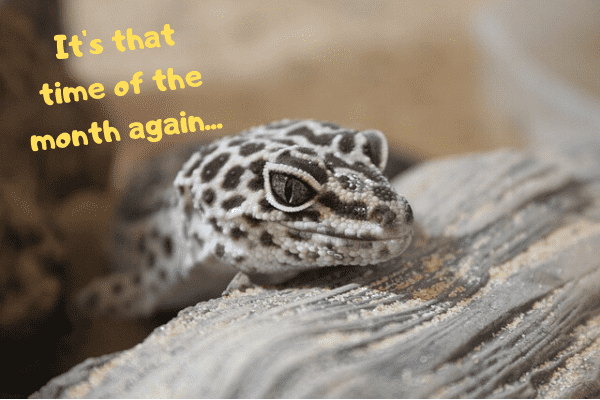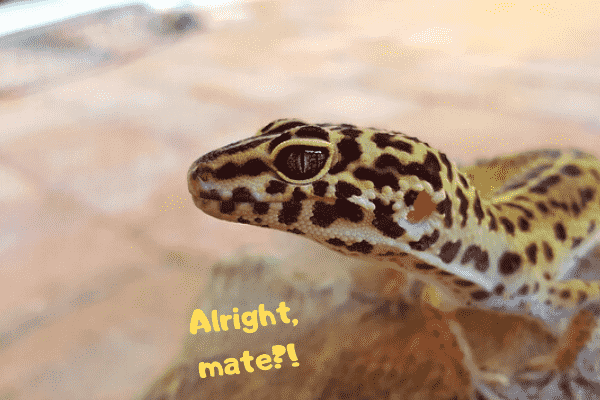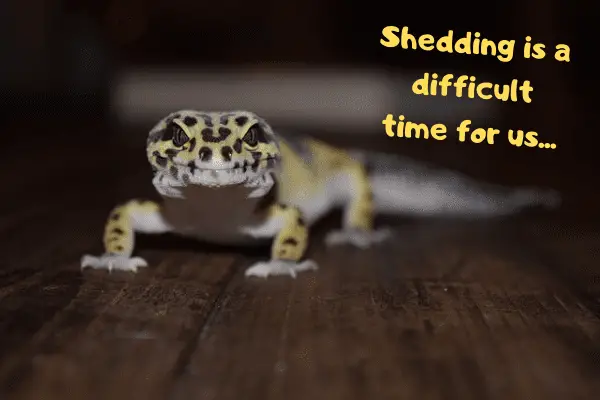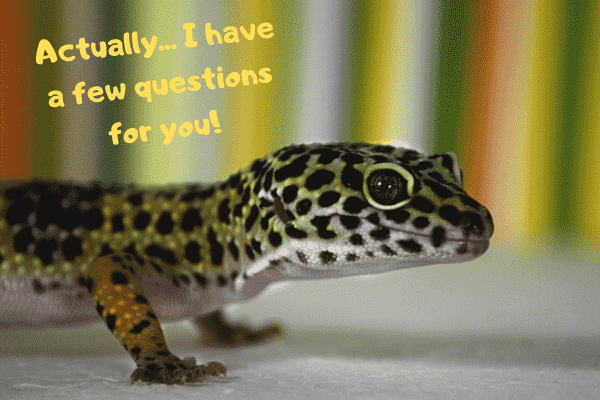When it comes to a leopard gecko shedding its skin, there’s a lot to take into account. Leopard gecko shedding is a topic we’re going to cover thoroughly in this guide as there are often a lot of questions when it comes to leopard gecko shedding care.
Leopard geckos are slightly more difficult shedders than many other lizards, but if they are given the right husbandry there usually aren’t any issues.

Table of Contents
Leopard gecko shedding behavior
Leopard geckos shed their skin because it no longer accommodates their size, or simply gets old. Us humans also shed our skin, but we do it gradually, so no one knows that we’re actually leaving pieces of ourselves everywhere we go (Eeew… I know).
On a more serious note, it’s quite normal for your leopard gecko to shed its skin quite often as it’s growing to maturity. As they mature, they will start shedding a little less often. This is completely normal and healthy behaviour, so don’t worry if your leopard gecko starts shedding less as they grow up.
Unfortunately, leopard gecko shedding comes with some complications for us reptile keepers. It can cause some problems in the daily care for your leo and that’s exactly why we had to write this article!
In this article we’re going to cover:
- How leopard gecko shedding works
- Leopard gecko shedding care
- General shedding problems
- Shedding problems on and around the eyes
- Shedding problems on the head
- Shedding problems on the toes
- Shedding problems on the tail
- Tips
- FAQ’s
If you’re looking for a complete guide on leopard gecko shedding then this is the right guide for you!
How leopard gecko shedding works
Your leopard gecko starts shedding when the skin moves from its “resting state” to its “dividing state.”
As the shedding process starts, your leopard gecko’s skin color will start getting less pronounced. It will get dull and lose its vibrant look. Once the skin underneath has had enough time to strengthen, the top layer of skin starts coming apart from it.
Your leopard gecko has now started shedding it’s skin. Your leo now has a thin layer of skin that is slowly loosening around him/her.
In most cases, the head will come off first and the rest will peel off from front to back. Of course, this is far from always the case. It’s a natural process so don’t worry too much if it doesn’t go exactly as any book, blog post or video says it should.
Once your leopard gecko is done shedding it should have a wonderfully bright coloration. As time passes again, the coloration will get duller until eventually, the process starts again!
This process tells you a lot about the health and conditions your leopard gecko is in. Shedding problems can be a major cause for concern and should be dealt with immediately!
We’ll get into shedding problems in a moment, but first, let’s talk at caring for your leopard gecko during shedding. After all, prevention is the better option.

Leopard gecko shedding care
There are a lot of things that you can do to ensure your leopard gecko is able to shed properly. Some of these things are constant, while others should only be done when you start noticing that they are shedding.
- Ensure your gecko has a good living environment
Bacterial infections, parasites and disease can all cause shedding problems. By providing your gecko with a clean living environment you can minimize the chances of them having these issues.
Make sure to remove
Diet is another important factor in preventing shedding problems caused by bacterial infections and disease.
- Diet!
We’ve already covered leopard gecko diet in this previous post. When it comes to shedding, there’s one thing that’s most important when it comes to their diet.
Supplementation!
You need to make sure your gecko is receiving the supplements it needs. Make sure you dust your crickets or mealworms thoroughly with a high-quality supplement. You can even provide a small shallow dish of supplement powder in the enclosure as an extra way for your leo to get the nutrients he/she needs.
- Humidify the hides
Your leopard gecko’s hides don’t always have to be humid, but when it comes to shedding time it’s best to give the hides a few sprays of water from time to time.
A humid environment will ensure your gecko sheds much easier and it will often choose a humid hide over a “dry hide” when they are shedding.
If you make sure to follow these 3 steps, you’ve got your leopard gecko shedding care down!
However, as already discussed, you can still face problems. Leopard gecko shedding is a natural process which means there can be issues during the process. I can tell you that everything will all go great if you do these 3 things, but I don’t think there’s a reptile owner out there that would agree with that.
Leopard gecko shedding help
If there are still parts of shed skin that aren’t coming off, there are a few different things you can do to help your leopard gecko complete its shed.
We’ll get into body-part specific ways in the next part on leopard gecko shedding difficulties. For now, we’ll just cover the general shedding help.
Obviously, we’ve already talked about moistening the hides. This should help the shedding process a lot.
On top of this, you can place your gecko into shallow pools of water, or even ever-so-gently spray some mist on them. Since this may annoy your leopard gecko, it can be better to use a cotton bud to moisten around the skin.
How you do it really depends on your gecko’s personality. The main point here is that water helps to loosen the dead skin!
If, after a day or two, your leo still has some pieces of dead skin on it, you can lightly try to remove it.
Preferably, use your hand and avoid hard objects like tweezers or your nails. Just gently stroke the skin in the direction that will help it come off. Your gecko should move in such a way that will help to remove it.
Important: BE GENTLE!
Side note: Leopard gecko eating shed skin
Leopard geckos will eat their shed skin. This has a few benefits, the first being that it provides a good boost in nutrients to your gecko. In the wild, it also prevents other animals from seeing
Always try to feed the skin to your Leo, or place it in his/her enclosure. After a day or two, you can remove it to prevent the enclosure from getting too dirty.
If it’s still not coming off, try repeating the process. If you really need to and have no other choice, you can use tweezers or gently try using your nails. However, it’s best to avoid doing that as it may injure your leo. Just be patient and it really should come off if you’re following this process.
If there are big issues with the shed not coming off, make sure to take a deep look at the husbandry you’re providing your leopard gecko. This should prevent it from happening in the future.
There are certain body parts that tend to be a challenge when shedding, these are going to be covered next!

Leopard gecko shedding difficulties
Shedding problems with leopard geckos is a common occurrence. There are a lot of leopard geckos that experience shedding difficulties, sometimes these are minor and sometimes they are a cause for concern.
Since I’m not a vet, I’m not going to go into the major leopard gecko shedding issues. Tracking your leopard gecko’s weight, how their faeces looks and how they are eating will help you identify if there’s a need to go to the vet with your L
There are some more-common issues that don’t require you to go to the vet. These are the things we’re going to cover in this leopard gecko shedding guide.
Leopard gecko shedding problems – head
Leopard gecko shedding problems on the head are a nuisance. Shed skin will often get stuck on the nose, eyes and ears of the gecko.
Usually, this is no cause for concern, but it may require some help from your part. More on this a little later.
Shedding problems around a leopard gecko’s head usually relieve themselves after around 12 to 24 hours. Any stuck shed should have come off by then.
If not, you can use the techniques mentioned in the chapter on leopard gecko shedding help to help it comes off.
Be very careful around your gecko’s ears, eyes and nose. Never pull the skin out of its ears. As a rule of thumb, never forcefully pull it off your gecko anywhere on the body!
Leopard gecko shedding problems – eyes
When it comes to leopard gecko shedding problems around the eyes, things can get a little more serious. Leopard geckos can actually get eye infections from shedding, which can cause major problems.
In almost all cases, leopard geckos will shed the skin on their eye lids in normal fashion. Sometimes, it will get stuck to the corners of their eye, however.
If you don’t see an improvement after 12-24 hours, you can use a cotton bud to moisten the area. Again, be very careful here!
Make sure you try moistening the hides first, as poking things in your gecko’s eye is obviously the last thing you want to be doing!
That being said, removing the dead skin is a priority if you want to prevent eye infections and other complications.
Try to make sure the cotton bud you use is as sterile as possible. Don’t wipe it over other surfaces or leave it lying around before use.
Be very gentle and make sure the cotton bud is nice and moist. The skin should then come off easily.
If there’s a large piece of skin still on it, it may be best to moisten it and then ever-so-gently removing the skin with your hands.
Should your gecko get an eye infection from shedding, make sure to take it to the vet!
Leopard gecko shedding problems – tail
When a leopard gecko’s shed is stuck on its tail, things
As long as you’re gentle, you can use the normal technique explained in the chapter on leopard gecko shedding help. The shed should then come off in a matter of hours.
Leopard gecko shedding problems – toes
Leopard gecko’s shedding on their toes is a real pain. When a leopard gecko’s shed is stuck on toes, it can be a painstakingly long process of moisturizing and gently peeling.
It’s very important that you get all of the shed skin off of your leopard geckos’ toes, so take your time when removing it. Failing to take it off, or being too rough, can damage the toes or cause them to fall off.

FAQ’s
How often should my leopard gecko shed?
There’s no set amount of time there should be betweens your leopard gecko’s sheds. I’ve seen leopard geckos shed every 2-3 weeks or every 6-weeks. When leopard geckos are young they tend to shed more often as they are still growing. The important thing is that they shed regularly and the shedding process goes well.
Is my leopard gecko shedding too much?
Leopard geckos shed at different paces and shedding too much isn’t really a problem. There may be a problem with weight loss, but this can easily be solved by upping the amount of food you give them along with monitoring their weight if they shed often.
If your leopard gecko sheds often, make sure to feed them enough to deal with the shedding and ensure they get enough supplementation.
Do leopard gecko’s stop eating when they shed?
Yes, leopard gecko’s will often eat very little, or stop eating entirely while shedding.
Should I feed my leopard gecko while shedding?
Yes and no! Leopard geckos tend to lose their appetite when they start shedding, but you can try to feed them something. If they don’t go for it, then just take it back out of their cage. They will start eating normally again once they are done shedding.
Why is my leopard gecko shedding so much?
Leopard geckos shed often when they are little. Some will still shed quite often when they are older. This is normal and is usually nothing to worry about. Keep an eye on their weight though! If they lose weight, make sure you feed them more or more often.
If you are very concerned, take them to see a vet.
Should I help my leopard gecko shed?
You should only help your leopard gecko shed if there is still dead skin on your gecko after a little while. Leaving it on there can cause problems, so if it isn’t coming off by itself or when applying some moisture, you can help him/her out a little bit. Be gentle though!
Does shedding hurt leopard geckos?
If the shedding goes well, it probably doesn’t hurt them. Unfortunately, they can’t talk, so there’s no way of knowing for sure. If shedding causes eye infections or toes to come off, we can probably guess that it does hurt!
Are leopard gecko’s supposed to eat their skin?
Yes! Leopard geckos eat their skin to prevent wasting all that nutritious goodness! It also helps keep their environment clean. Leopard gecko’s eating their skin is completely normal.
Why do leopard geckos eat their own skin?
Leopard geckos eat their own skin because it’s nutritious for them. In the wild, it also prevents predators from finding out where they live and it keeps their living space clean!
What happens when a leopard gecko sheds its skin?
When a leopard gecko sheds its skin, it’s skin start dividing and then the top layer slowly comes off. It does this so that the gecko can grow.
Leopard gecko shedding tips
- Keep an eye on your gecko’s weight before, during and after shedding. This can help you track the health of your gecko.
If you do this consistently, you can easily spot complications well before owners who don’t do this.
- If your leopard gecko starts feeding again and there are still pieces of skin attached, start following the steps in this guide.
- Take a look at our leopard gecko care guide to ensure you’re providing the optimal care for your leo!
Conclusion
As you can see, there’s a lot that goes into leopard gecko shedding. Even though it’s a natural process and it doesn’t go perfectly in the wild, we as care givers have the responsibility to care for our leopard gecko in the best way possible.

